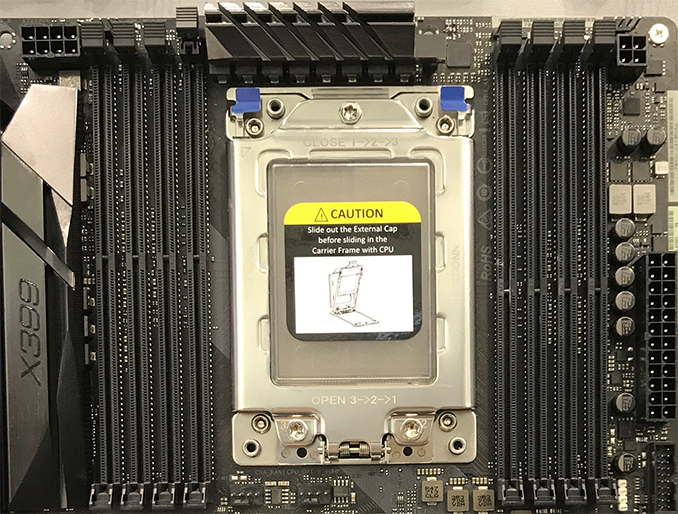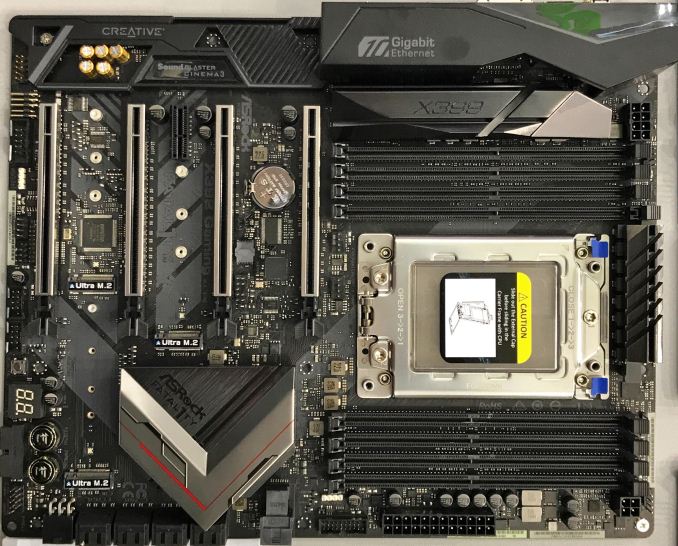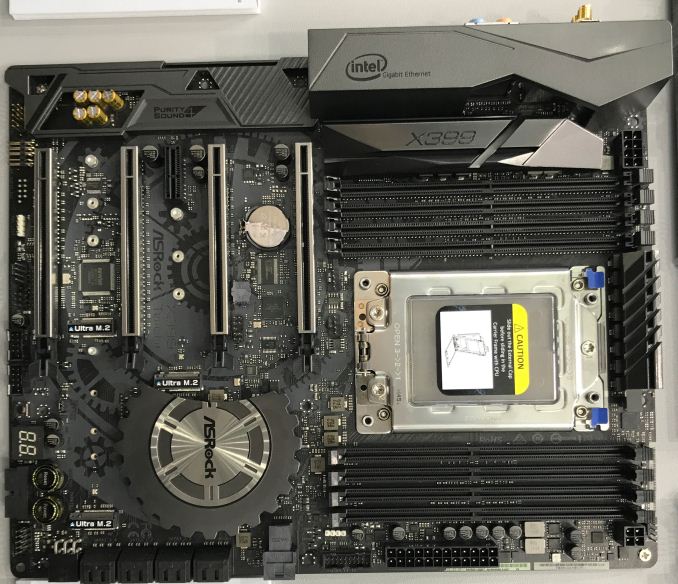ASRock Demos X399 ‘ThreadRipper’ Motherboards: M.2, U.2, 10 GbE, & More
by Anton Shilov on June 7, 2017 10:00 AM EST- Posted in
- Motherboards
- AMD
- ASRock
- Trade Shows
- Ryzen
- Computex 2017
- ThreadRipper
- X399

At Computex last week, ASRock demonstrated two motherboards designed for AMD’s upcoming ThreadRipper HEDT processors. The new platforms are for high-end workstations and designed to support up to four graphics cards though the 60 PCIe lanes from the CPU, over a dozen of storage devices and up to eight DIMMs. To a large degree, ASRock’s motherboards reflect overall positioning of the AMD X399 “ThreadRipper” platform as a premium high-end desktop play, and what to generally expect from makers of mainboards here.
ASRock plans to offer two motherboards for AMD’s ThreadRipper CPUs: the X399 Professional Gaming and the X399 Taichi. The mainboards are based on the same PCB (and the same AMD X399 chipset/socket), but have a slightly different feature set. The ThreadRipper motherboards that ASRock demonstrated at Computex featured an eight-phase digital CPU VRM, which is the feasible limit given the physical space available, but we have no idea the capabilities of the power delivery as of yet. ThreadRipper is meant to be a high performance, high power processor, so undoubtedly the motherboard vendors have built their boards to match. When it comes to the socket itself, it has 4094 pins and is very large (not surprising given its origin). We've seen the socket referred to as SP3r2 and TR4, although the official word from AMD is that it is the 'X399 platform'.
It will be interesting to see whether any motherboard maker manages to design a Mini-ITX mainboard for the ThreadRipper, but we will see. As we understand it, one of the problems with the socket, apart from the dimensions, is its cost to manufacturers that is prohibitively high at this time.
Both of the X399 motherboards from ASRock have eight DDR4 memory slots, but the manufacturer does not disclose speeds, ECC support and other details (although given previous discussions, we expect at least ECC and DDR4-2400). In fact, it does not even reveal the maximum amount of memory supported by the CPU. Though even if the company does know, it's almost certain that AMD wants to hold all of these cards close to their chest for future product announcements.
The X399 Professional Gaming physically has four PCIe 3.0 x16 slots (electrically set at two x16 and two x8) that can support up to four-way AMD CrossFireX or NVIDIA SLI multi-GPU configurations, as well as PCIe SSDs. In addition, there is a PCIe 3.0 x1 slot. As for storage options, ASRock has most configurations covered: the motherboard carries eight SATA ports, a U.2 connector, as well as three M.2 slots. To ensure that there is enough power for the latter, there is a 6-pin PCIe power connector right near the SATA ports. As for network connectivity, the motherboard features a 10 GbE port using Aquantia's AQC solution, two GbE headers (enabled by Intel controllers), as well as a 2x2 802.11 Wi-Fi module with Bluetooth. As for USB, there are 10 USB 3.0 ports in addition to two USB 3.1 ports (Type-A and Type-C) on the back panel. Finally, the X399 Professional Gaming has a 7.1 audio sub-system enhanced using Creative Labs’ SoundBlaster software.
| ASRock's X399 Professional Gaming and X399 Taichi for AMD ThreadRipper CPUs | |||
| X399 Professional Gaming | X399 Taichi | ||
| CPU Support | AMD ThreadRipper CPUs in LGA4094 form-factor | ||
| Graphics |
4 × PCIe 3.0 x16 (2 × x16, 2 × x8) |
||
| Chipset | AMD X399 | ||
| Memory | Eight DDR4 DIMM slots | ||
| Ethernet | 1 × 10 GbE Aquantia AQtion AQC107 2 × Intel GbE controllers |
2 × Intel GbE controllers | |
| Storage | 8 × SATA 6 Gbps 3 × M.2 (PCIe 3.0 x4 or SATA) 1 × U.2 (PCIe 3.0 x4) |
||
| Audio | Realtek ALC1220 (?) 7.1 channel audio with Creative Labs SoundBlaster Cinema 3 enhancements |
Realtek ALC1220 (?) 7.1 channel audio with ASRock Purity Sound 4 |
|
| USB | 8 × USB 3.0 Type-A 1 × USB 3.1 (Gen 2) Type-A 1 × USB 3.1 (Gen 2) Type-C |
||
| Other I/O | Dual band 802.11ac Wi-Fi + Bluetooth 4.x, PS/2 | ||
| Form-Factor | ATX | ||
| MSRP | Expensive | Less Expensive | |
It is worth nothing that we expect the X399 chipset to be as capable as the AM4 X370 platform, which means that some of the features on the motherboard are likely to have shared resources, meaning having one enabled will disable some others. AMD has engineered the CPU to have 60 PCIe lanes for storage and graphics, which will nominally mean most configurations will allow three GPUs (totalling 48 lanes) and three M.2 slots (totalling 12 lanes) although the 10GbE controller will require some lanes as well as the other Ethernet and perhaps a USB port controller or two. Until we see the chipset diagram, it will be hard to tell at this point.
The ASRock X399 Professional Gaming and the X399 Taichi will be available later this year when AMD releases its ThreadRipper CPUs. It goes without saying that the motherboards are not going to be cheap: they are not designed for general consumers and their server origin will have a direct impact on pricing.
Related Reading:
- AMD CPU Updates: 16 Core ThreadRipper w/64 PCIe Lanes This Summer, Epyc Launching June 20th
- AMD Announces Ryzen AGESA 1.0.0.6 Update: Enables Memory Clocks Up To DDR4-4000
- Computex 2017: AMD Press Event Live Blog
- ASRock Announces X299 Professional Gaming i9 with 3-Way Multi-GPU, 10Gb Ethernet, & Wi-Fi
- Intel Announces Skylake-X: Bringing 18-Core HCC Silicon to Consumers for $1999
- Intel Announces Basin Falls: The New High-End Desktop Platform and X299 Chipset
Source: ASRock












69 Comments
View All Comments
Samus - Thursday, June 8, 2017 - link
It doesn't seem to be uncommon (although I'm surprised as you are) to see Intel NIC's on AMD boards recently. Nobody can take Atheros, Broadcom or Realtek seriously I guess, although HP has been using Broadcom NIC's in their servers for years now, and they are quite good.close - Thursday, June 8, 2017 - link
High-end AMD boards have used Intel NICs before. Many ROG boards did. But since the controller is more expensive the mid- and low-end boards didn't get it.ianochez - Tuesday, July 18, 2017 - link
ahahah just seen it. really funnynathanddrews - Wednesday, June 7, 2017 - link
1x10GbE and 2x1GbE? That's real nice. So what's the 16C/32T R9 Threadripper going to cost? $699? $999? $1,299?mkaibear - Wednesday, June 7, 2017 - link
Well, the Intel Xeon E5-2643 is I believe Intel's cheapest 16core/32thread CPU and that comes in at an RRP of $1846.00 - so I would suspect the Threadripper to come in at maybe $1500.Flunk - Wednesday, June 7, 2017 - link
I'd suspect a starting price closer to $1000, AMD really has to undercut Intel here to be considered in the top-end market because they lose in per thread performanceMrTeal - Wednesday, June 7, 2017 - link
I'd probably agree. Given the 1800X launched at $499 and just got cut to $469, it's hard to imagine TR will be priced much north of $1k if it crosses that barrier at all.firerod1 - Wednesday, June 7, 2017 - link
I think $999 max is a safe bet, since its exactly double the 1800x in price/cores/threads. Then they can just cut the price a few months later lol.beginner99 - Thursday, June 8, 2017 - link
I've heard as low as $849 for cheapest 16-core. Reason being that mainboards will cost a lot. More than x299 and $350 is probably for the lowest end models. So the 8-core TR will be priced exactly as the 1800x but you pay 2-3x as much for the mobo.ddriver - Thursday, June 8, 2017 - link
There is no good reason for the motherboard to cost that much. It is basically your generic ryzen board, the only extra is the additional memory slots and I/O interconnect. Obviously, extra featured will add to the cost, such as 10gbit ethernet, but those are not mandatory, and without them, the price premium for threadripper mobos shouldn't be more than 50$ or so.